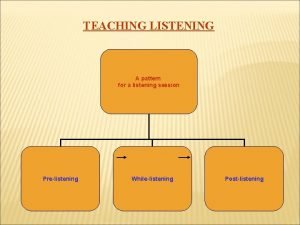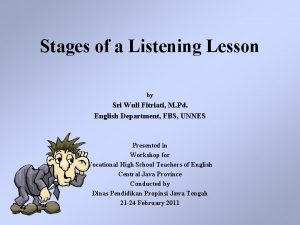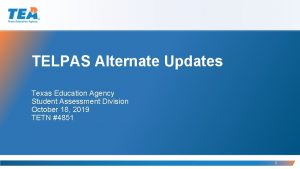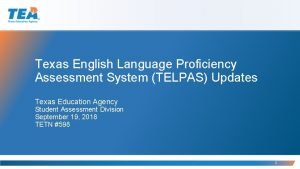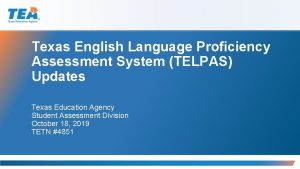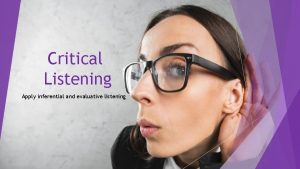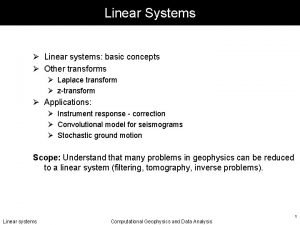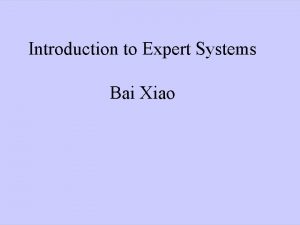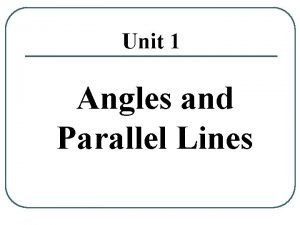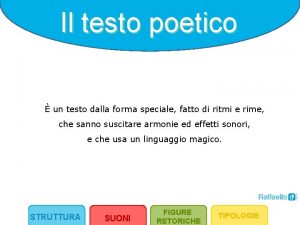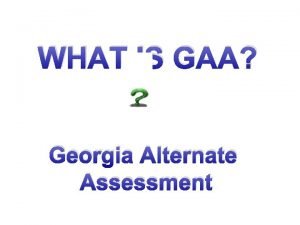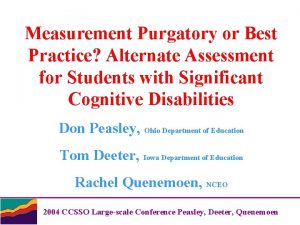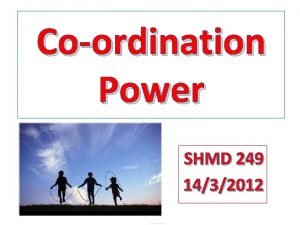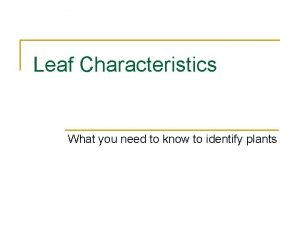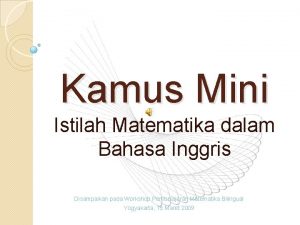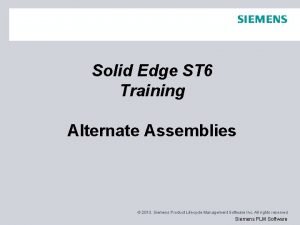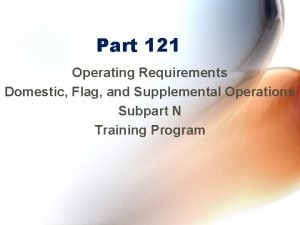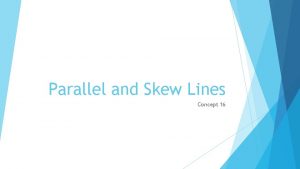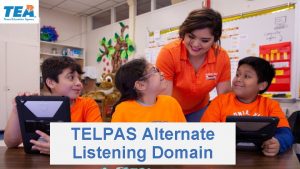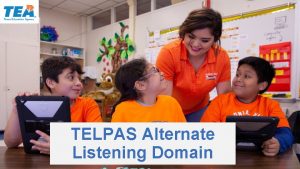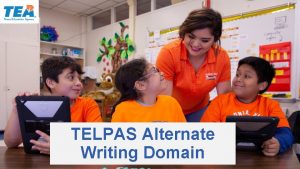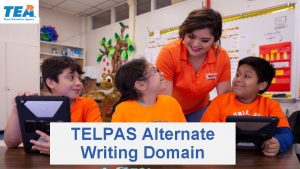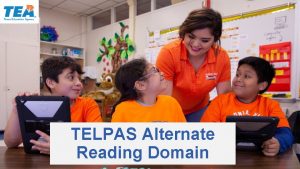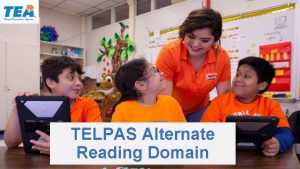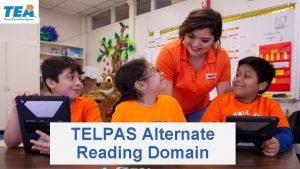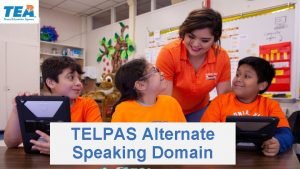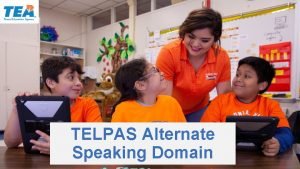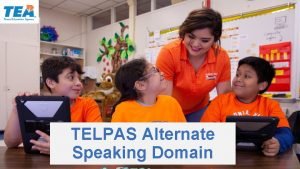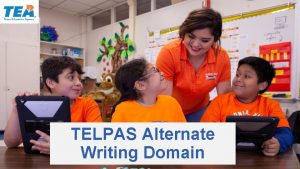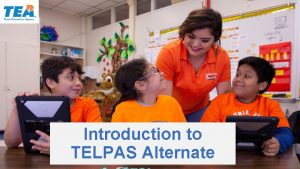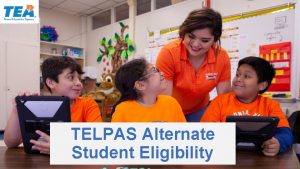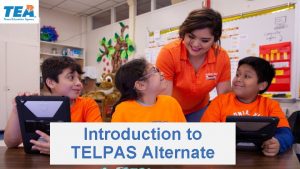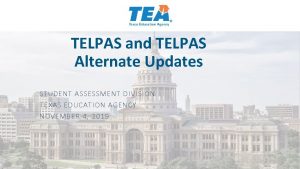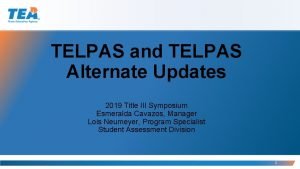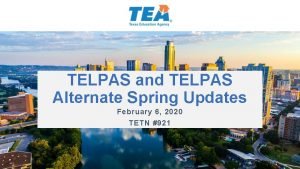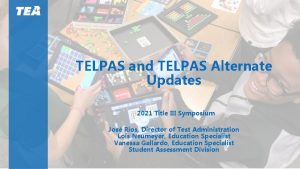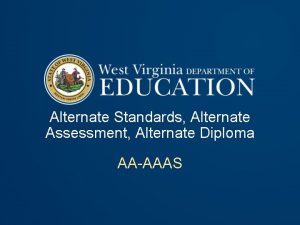TELPAS Alternate Listening Domain Purpose of this TELPAS






























- Slides: 30

TELPAS Alternate Listening Domain

Purpose of this TELPAS Alternate Training • Intended for classroom teachers who will be administering TELPAS Alternate during the testing window § Can be used by others (e. g. , test coordinators, administrators, parents) as needed in order to clarify different aspects of this testing program • Explains the Alternate Proficiency Level Descriptors and Observable Behaviors for Listening • Provides classroom examples of the Listening Observable Behaviors • Describes ways to make the Listening Observable Behaviors more accessible for students Texas Education Agency 2018 -2019 School Year 2

Alternate Proficiency Level Descriptors • TELPAS Alternate is a holistic inventory aligned to the Texas English Language Proficiency Standards (ELPS). • This inventory is based on alternate Proficiency Level Descriptors (PLDs) that were created to address the specific access needs of English learners with significant cognitive disabilities. • The PLDs can be used to better understand the intent and scope of specific Observable Behaviors. • The PLDs can be used to provide a summary of a student’s general English listening ability after scoring. Texas Education Agency 2018 -2019 School Year 3

Alternate Proficiency Level Descriptors: Listening Texas Education Agency 2018 -2019 School Year 4

What are Observable Behaviors? • In TELPAS Alternate, the Observable Behaviors are like questions the test administrator answers about a student. Each Observable Behavior measures one skill that is aligned to the ELPS. The skill can be found on the left under the number of the Observable Behavior. The boxes contain descriptions of characteristics that students learning English are likely to demonstrate over time. The descriptors show the progression of second language acquisition from one proficiency level to the next and are aligned to the TELPAS Alternate PLDs. • A “notes version” of the Observable Behaviors can be found on TEA’s TELPAS Alternate Resources web page. It is available so that educators can become familiar with the Observable Behaviors and practice using them during the school year. Texas Education Agency 2018 -2019 School Year 5

Observable Behaviors and the Glossary You may discover vocabulary in the Observable Behaviors that might be used in a way that differs from common classroom usage. The TELPAS Alternate Test Administrator Manual includes a glossary with terms specific to this assessment that may assist you. Texas Education Agency 2018 -2019 School Year 6

Observable Behaviors with Classroom Examples • Texas teachers developed classroom examples to help test administrators better understand the descriptions of student performance for each Observable Behavior. • Elementary and secondary examples describe one way that students could demonstrate each skill across the five levels of proficiency. An accessible version of the Observable Behaviors and classroom examples can be found at https: //tea. texas. gov/student. assessment/telpasalt/#Alt Texas Education Agency 2018 -2019 School Year 7

Using the Classroom Examples • The purpose of each example is to illustrate how a student could demonstrate the skill at each proficiency level. • There are many other classroom activities that could be used as examples for the Observable Behaviors. • These examples are not intended to be used as test questions or performance tasks for teachers to replicate, although using them for this purpose is acceptable if needed. • Teachers are encouraged to use their own activities in the regular classroom setting when determining a student’s ability to understand use English. Texas Education Agency 2018 -2019 School Year 8

Observable Behavior L 1. Distinguishing Sounds with Classroom Examples Elementary Student does not show a reaction when teacher shows a picture of a dog, says the initial sound for “d, ” and then “dog. ” Student matches the picture of a dog to an identical picture after teacher shows the dog picture and makes the sound for “d. ” Student reads the word cards “dog” and “duck. ” Student places the cards on a graphic organizer indicating they have the same initial sound. Student identifies the initial “d” sound and the final “g” sound after hearing the word “dog. ” Student identifies “cat/cat” as the same, and “cat/cap” as different after hearing them spoken aloud. Secondary Student does not show a reaction when the teacher shows a picture of a rat, says the initial sound for “r, ” then “rat. ” Student matches the picture of a rat to an identical picture after teacher shows the rat picture and makes the sound for “r. ” Student reads the word cards “bat” and “rat. ” Student places the cards on a graphic organizer indicating they have the same final sound. Student identifies the initial “r” sound and the final “t” sound after hearing the word “rat. ” Student identifies “rat/rat” as the same, and “rat/mat” as different after hearing them spoken aloud. Texas Education Agency 2018 -2019 School Year 9

Observable Behavior L 2. Understanding Conjunctions with Classroom Examples Elementary Student does not attend to the pictures of milk and juice after teacher shows the pictures and asks, “milk or juice? ” Student selects a picture of “milk” when given spoken choices paired with pictures of “milk” or “juice. ” Student selects “milk” when given spoken choices of “milk”, “juice”, or “water. ” Student chooses “white milk and juice” when given spoken choices of “white milk and juice” or “white milk and water. ” Secondary Student does not attend to the pictures of pizza and a hamburger after teacher shows pictures and asks, “pizza or hamburger? ” Student selects a picture of “pizza” when given spoken choices paired with pictures of “pizza” or “hamburger. ” Student selects “pizza” when given spoken choices of “pizza”, “hamburger” or “salad. ” Student selects “cheese pizza and water” when given spoken choices of “pepperoni pizza and water” or “cheese pizza and water. ” Texas Education Agency 2018 -2019 School Year 10

Observable Behavior L 3. Using Vocabulary with Classroom Examples Elementary Student does not react when teacher says, “schedule” and shows a picture of a schedule. Student chooses an identical picture of a schedule after teacher shows a picture of a schedule and says “schedule. ” Student points to a picture of the next task from a visual schedule when given the verbal request “What is next? ” Student touches a word/picture combination for “holiday” from a visual schedule given the verbal request “What is next? ” Student verbally responds with a short discussion when asked, “What is on your schedule this afternoon? ” Secondary Student does not react when teacher says “vote” and points to a picture of a person voting. Student chooses an identical picture of a person voting after teacher shows a picture of a person voting and says “voting. ” Student points to a picture of someone voting from a group of pictures when teacher says “voting. ” Student picks up a word/picture combination for “voting” from a group of word/picture combinations when teacher asks, “Which picture shows voting? ” Student verbally responds with a short discussion when asked, “Why do people vote? ” Texas Education Agency 2018 -2019 School Year 11

Observable Behavior L 4. Understanding Media with Classroom Examples Elementary Student turns toward a short video about magnets. After watching a video about hand washing, teacher asks, “What was the video about? ” Student points to a picture of hand soap when given two pictorial choices. After viewing a narrated Power. Point presentation about classroom rules, student circles a picture that represents students following directions in the classroom setting when given several choices. After viewing a video, student sequences a few pictures retelling the main points of the media presentation about magnets. After watching a video, student sequences multiple pictures retelling the steps to complete a science experiment when asked to retell the events. Secondary Student does not turn toward a video clip of the life cycle of a butterfly. After watching a video presentation about the life cycle of a butterfly, teacher asks, “What was the video about? ” Student points to a picture representing the life cycle of a butterfly when given two pictorial choices. After watching a video presentation, student points to a word/picture combination representing the life cycle of a butterfly from many choices of different science topics. After watching a video presentation, student places a few pictures in chronological order representing the steps in the life cycle of a butterfly when asked to retell the events. After watching a video presentation, student places multiple pictures in chronological order representing the steps in the life cycle of a butterfly when asked to retell the events. Texas Education Agency 2018 -2019 School Year 12

Observable Behavior L 5. Understanding the General Meaning with Classroom Examples Elementary Student does not pay attention to the spoken word “earth” when shown a model of the earth. Student grabs a picture of the earth from a group of pictures when presented with the spoken word “earth” and an identical picture of the earth. Student circles a picture of the earth from a group of pictures when presented with the spoken word “earth. ” Student picks up a picture of the earth with its moon from a group of pictures after a simple classroom discussion about the earth and moon. Student points to a diagram showing the earth’s orbit from a group of pictures after hearing a detailed classroom discussion about the earth’s orbit. Secondary Student touches teacher after hearing the spoken word “tundra” and shown a picture of the tundra. Student grabs a picture of the tundra from a group of pictures when presented with the spoken word “tundra” and an identical picture of the tundra. Student circles a picture of the tundra from a group of pictures when presented with the spoken word “tundra. ” Student picks up a picture of the tundra from a group of pictures after a simple classroom discussion about the tundra ecosystem. Student points to a picture of permafrost from a group of pictures after hearing a detailed classroom discussion about features of the tundra ecosystem. Texas Education Agency 2018 -2019 School Year 13

Observable Behavior L 6. Understanding the Main Points with Classroom Examples Elementary Student does not look at teacher reading the book If You Take a Mouse to School. Student places the word “mouse” on the picture of a mouse in the book If You Take a Mouse to School when teacher reads the story orally. Student holds up a picture of a mouse every time he or she hears the word “mouse” while teacher orally reads If You Take a Mouse to School. Student points to a picture of a school from a three picture choices, when asked the question “Where did the mouse go? ” Student answers the question “What does a plant need to grow? ” after an oral presentation of Magic Scholl Bus Gets Planted. Secondary During an oral presentation of a shortened version of the novel Holes, student gazes at teacher reading the word “dig “ paired with a picture (after hearing the word repeated several times). Student places a picture of the word “dig” next to a picture of someone digging a hole (after hearing the word repeated several times). Student points to a picture of someone digging a hole from a choice of three pictures (after hearing the word repeated several times) Student points to a picture of Stanley teaching Zero to read after being asked, “How did Stanley help Zero? ” After being asked direct questions, student discusses why friendships are important. Texas Education Agency 2018 -2019 School Year 14

Observable Behavior L 7. Identifying Important Details with Classroom Examples Elementary Student does not look at teacher when teacher discusses character traits from “The Three Little Pigs. ” Student matches a picture of the Big Bad Wolf from a choice of pictures after teacher orally presents the story of “The Three Little Pigs. ” Student points to a picture of the Big Bad Wolf from a choice of pictures after teacher orally presents the story of “The Three Little Pigs. ”. Student holds up a picture of the third little pig once the story has been orally presented and when prompted by the teacher. Student identifies details by answering questions after listening to the story Ferdinand. Secondary During a read-aloud of a simplified version of the myth “King Midas, ” student may turn toward teacher discussing characteristics of King Midas paired with pictures portraying King Midas. Student places a picture of the character King Midas next to an identical picture of King Midas from the book. Student points to the picture of King Midas when presented three choices. Student points to the words “loved gold” from three choices (read aloud to the student) when prompted by the teacher. Student points to details describing King Midas (read by the teacher) from several choices. Texas Education Agency 2018 -2019 School Year 15

Observable Behavior L 8. Following Directions with Classroom Examples Elementary Student does not stand when given the one-word direction “stand. ” Student stands when given the direction “stand” with picture support. Student stands when given the one-word direction “stand. ” Student follows the directions “stand up, ” sit down, ” and “raise your hand. ” Student follows the directions “stand up, walk to the door, and wait quietly. ” Secondary Student does not walk when given the one-word direction “walk. ” Student walks when given the direction “walk” with picture support. Student walks when given the one-word direction “walk. ” Student follows the directions “walk to door”, “walk to the restroom”, ” and “wash your hands. ” Student follows the directions “stand up, walk to the restroom, and wash your hands. ” Texas Education Agency 2018 -2019 School Year 16

Observable Behavior L 9. Retelling with Classroom Examples Elementary During a read-aloud of The Very Hungry Caterpillar, student gazes at the pictures showing the caterpillar first eating the apple and then the pears, as teacher reads that the caterpillar first ate an apple and then ate two pears. Student reaches for the picture of an apple after hearing teacher read aloud that the caterpillar first ate an apple and then ate two pears, and asks, “What did the caterpillar eat first? ” Student puts pictures in order from the story The Very Hungry Caterpillar. Student sequences word/picture cards representing the events from the story The Very Hungry Caterpillar. Student identifies the main points after listening to the story The Cat in the Hat. Secondary During a read-aloud of a simplified version of The Watsons Go to Birmingham -1963, student looks toward teacher while teacher reads, “First Byron kisses the mirror, then his lips get stuck. ” Student points to the picture of Byron’s lips sticking to the mirror after teacher asks, “First Byron kisses the mirror, then what happens? ” Student places pictures of Byron kissing the mirror, Byron with his lips stuck to the mirror, and Dad pulling him off the mirror in sequential order. Student places teachermade cards with the phrases “Byron kisses the mirror, ” “Byron gets his lips stuck to the mirror, ” and “Dad pulls him off the mirror” in the correct order. Student identifies the main points after listening to the story The Watsons Go to Birmingham – 1963. Texas Education Agency 2018 -2019 School Year 17

Observable Behavior L 10. Responding to Questions with Classroom Examples Elementary Student gazes at the pencil when asked, “Where is the pencil? ” Student points to a picture when asked, “Which one is blue? ” Student grabs a word/picture card of a pencil when asked, “What do you use to write your name? ” Student selects the correct mode of transportation when asked, “How do you get to school? ” Student verbally responds to the questions, “What time do you wake up, ” “What time do you get to school, ” and “What time do you eat lunch? ” Secondary Student looks at the speaker when asked, “What is your name? ” When asked, “What city do you live in? “ and presented with a picture representing his/her city, student gives a partial answer. (Ex: “Antonio” for “San Antonio. ”) When asked, “What city do you live in? ” and presented with a picture representing his/her city, student verbalizes a correct response. When asked, “What state do you live in? ” student grabs a representation of the state of Texas when given three choices. Student verbally answers when asked, “What city, state and country do you live in? ” Texas Education Agency 2018 -2019 School Year 18

How to Determine Student Proficiency for Each Observable Behavior 1. Test administrators should consider only one Observable Behavior at a time. 2. Test administrators will read the skill and think about recent opportunities the student has had to practice that skill. Then test administrators will read the five descriptions of student performance for the Observable Behavior and use their current knowledge and observations of the student’s English language skills to make individual holistic judgments. Texas Education Agency 2018 -2019 School Year 19

How to Determine Student Proficiency for Each Observable Behavior, continued 3. Test administrators must consider the ability of each EL to use English in the domain of listening in the context of skills the student is learning and practicing in a classroom setting. § Think about how well the student has demonstrated the ability to understand or use English in the context of skills the student is learning. § Think about how well the student is able to understand or use English when practicing these skills in a classroom setting. 4. Select the description that closely matches the student’s performance most consistently. § Consistently: almost always acting, behaving, or responding in the same way Texas Education Agency 2018 -2019 School Year 20

On the Border • There is an early, a middle, and a late stage within each TELPAS Alternate proficiency level. Students in the early stage of a proficiency level might demonstrate language that drops down into the previous level at times, especially when working with academic language or new vocabulary and language structures. • Similarly, students in the late stage of a proficiency level will sometimes demonstrate language that reaches into the next level. • For each Observable Behavior, test administrators must consider the description that applies to each student most consistently. Demonstrating a new skill once or even occasionally does not mean a student has crossed over into a higher level of proficiency. Texas Education Agency 2018 -2019 School Year 21

Collaboration • For students who are in the very early or very late stage of a level, it is recommended that test administrators § collaborate with others or ask others familiar with the students for input, and § wait until later in the assessment window to see whether a couple of additional days of observation will help clarify the most appropriate description. Texas Education Agency 2018 -2019 School Year 22

Example of Rating a Student “On the Border”: Nela Ms. Easterday and her students are working on the skill “understanding the main points. ” Ms. Easterday consults notes that she has taken during the course of the school year about Nela’s progress in developing this skill. From her notes, she can see that Nela was having difficulty matching pictures at the beginning of the year. Lately, however, Ms. Easterday’s notes support that Nela is beyond the level of matching identical pictures and can now select the correct picture from a bank. She determines that Nela has moved to the higher level. 23

Example of Rating a Student “On the Border”: George The TELPAS Alternate administration window is open. Mr. Shelby is reviewing information about one of his students with some colleagues. From their notes, they see that George started out the year with the ability to follow simple one- and twoword directions. Though he has made progress, he is inconsistent when single-step directions are lengthy. Mr. Shelby determines that, even though George is peaking into the next level, he is still most consistently following simple one- and two-word directions. 24

Alternate Response Modes • For TELPAS Alternate, “English” is more inclusive to allow for all modes of communication in English. • Some English learners use sign language, braille, or another method of communication as a substitute for traditional English in one or more language domains. • Test administrators should allow students to use one or more alternate response modes on the following slide if the students regularly use the response mode(s) during instruction and in accordance with the individualized education program (IEP). • Alternate response modes are only intended for students who cannot listen, speak, read, or write in a traditional way. They are intended to address the communication needs of students based on their disability. Texas Education Agency 2018 -2019 School Year 25

Allowable Response Modes for the Listening Domain For the listening domain, it is allowable for a student to § alert to § gaze at § point to § reach for § touch or pick up § draw § circle § nod § gesture toward the targeted stimulus Texas Education Agency 2018 -2019 School Year 26

Prompting Versus Leading • Prompting is an action intended to initiate or continue a task that the student is being requested to complete. A prompt pulls the student through each step to the end of the task. • Leading is asking the student to respond in a specific way or with a specific answer. Leading is NOT allowed. • Prompting is allowed for rating the Observable Behaviors on the TELPAS Alternate assessment. § The purpose of TELPAS Alternate is to accurately measure a student’s ability to understand use English to engage in social and academic learning environments. § Prompting a student to respond to a task so that his or her ability to understand or use English can be accurately measured is acceptable. Texas Education Agency 2018 -2019 School Year 27

Available TELPAS Alternate Training Power. Points q Introduction to TELPAS Alternate q Reading Domain q Writing Domain q Student Eligibility q Accessibility q Listening Domain q Test Administration q Speaking Domain Texas Education Agency 2018 -2019 School Year 28

Contact Information TEA’s Student Assessment Division 512 -463 -9536 assessment. specialpopulations@tea. texas. gov Pearson’s Customer Service Center 800 -627 -0225 Tx. Pearson. Access@support. pearson. com Texas Education Agency 2018 -2019 School Year 29

Disclaimer These slides have been prepared by the Student Assessment Division of the Texas Education Agency. You are encouraged to use them for local training. If any of the slides are changed for local use, please hide or remove any TEA logos, headers, or footers. (You may need to edit the Master slide. ) In addition, you must remove the photographs. Only TEA has parental permission to use these photographs for training purposes. This training is not intended to replace any materials or additional information on the TEA website. Texas Education Agency 2018 -2019 School Year 30
 Listening pattern
Listening pattern While listening stage
While listening stage Telpas alt manual
Telpas alt manual Telpas headset requirements
Telpas headset requirements Telpas speaking rubric
Telpas speaking rubric Active listening passive listening
Active listening passive listening What is inferential listening
What is inferential listening Z domain to frequency domain
Z domain to frequency domain S domain to z domain
S domain to z domain Problem domain vs knowledge domain
Problem domain vs knowledge domain Codomain vs domain
Codomain vs domain Z transform tutorial
Z transform tutorial A_______ bridges the specification gap between two pls.
A_______ bridges the specification gap between two pls. Z domain to frequency domain
Z domain to frequency domain Domain specific vs domain general
Domain specific vs domain general Frequency domain to time domain
Frequency domain to time domain Domain specific vs domain general
Domain specific vs domain general On purpose sentence
On purpose sentence Specific purpose statement
Specific purpose statement Consecutive interior angles
Consecutive interior angles Filastrocca in rima alternata di 4 versi
Filastrocca in rima alternata di 4 versi Georgia alternative assessment
Georgia alternative assessment Ohio alternate assessment
Ohio alternate assessment Wall toss test average
Wall toss test average Alternate opposite whorled leaves
Alternate opposite whorled leaves 100 istilah matematika
100 istilah matematika Applying angle relationships
Applying angle relationships Solid edge alternate assemblies
Solid edge alternate assemblies Whats an alternate exterior angle
Whats an alternate exterior angle Part 121 alternate requirements
Part 121 alternate requirements Alternate exteior angles
Alternate exteior angles
